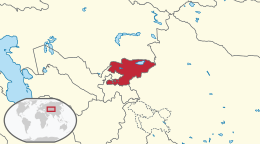Commons:Copyright rules by territory/Kyrgyzstan
|
Copyright rules: Kyrgyzstan Shortcut: COM:KYRGYZSTAN | |
 | |
 | |
| Durations | |
|---|---|
| Standard | Life + 50 years |
| Anonymous | Publish + 50 years |
| Other | |
| Freedom of panorama | No |
| Common licence tags |
{{PD-old-auto}} {{PD-KG-exempt}} |
| ISO 3166-1 alpha-3 | KGZ |
| Treaties | |
| Berne convention | 8 July 1999 |
| WTO member | 20 December 1998 |
| URAA restoration date* | 20 December 1998 |
| WIPO treaty | 6 March 2002 |
| *A work is usually protected in the US if it is a type of work copyrightable in the US, published after 31 December 1928 and protected in the country of origin on the URAA date. | |
This page provides an overview of copyright rules of Kyrgyzstan relevant to uploading works into Wikimedia Commons. Note that any work originating in Kyrgyzstan must be in the public domain, or available under a free license, in both Kyrgyzstan and the United States before it can be uploaded to Wikimedia Commons. If there is any doubt about the copyright status of a work from Kyrgyzstan, refer to the relevant laws for clarification.
Background
The Kyrgyz state, once independent, was incorporated into the Russian Empire in 1876. It became part of the Russian SFSR in 1919 as the Kara-Kirghiz Autonomous Oblast. In 1936 the Kirghiz Soviet Socialist Republic became a full republic of the Soviet Union. During the Soviet break-up, the republic became fully independent in 1991.
Kyrgyzstan has been a member of the Berne Convention since 8 July 1999, the WIPO treaty since 6 March 2002 and the World Trade Organization since 20 December 1998.[1]
As of 2018 the World Intellectual Property Organization (WIPO), an agency of the United Nations, listed Law No. 6 of January 14, 1998, on Copyright and Related Rights (as amended up to Law No. 42 of March 9, 2017) as the main copyright law enacted by the legislature of Kyrgyzstan.[1] WIPO holds the text of this law in their WIPO Lex database.[2]
General rules
Under Law No. 6 as of 2017,
- Copyright lasts for the life of the author and 50 years after death.[2017 Article 27(1)]
- Copyright in a work of joint authorship lasts during the lives of the authors and 50 years after death of the last survivor.[2017 Article 27(2)]
- Copyright in anonymous or pseudonymous works lasts for 50 years from 1 January of the year following the year of publication.[2017 Article 27(3)]
The compiler of a collective work such as an encyclopedia, encyclopedic dictionary, collection of scientific works, newspaper, magazine and other periodical publication has exclusive rights in the publication. However, unless otherwise agreed by contract, the authors of the works included in such publications retain the exclusive rights to the use of their contributions elsewhere.[2017 Article 11]
Not protected
See also: Commons:Unprotected works
Law No. 6 as of 2017 states that the following works are not subject to copyright[2017 Article 8]:
- Official documents (laws, regulations, decisions, etc.), as well as their official translations;
- Official symbols and signs (flags, emblems, medals, monetary signs, etc.);
- Works of folk art;
- Regular press information that constitute the daily news or information on current events;
Copyright tags
See also: Commons:Copyright tags
- In general, {{PD-Kyrgyzstan}} applies.
- {{PD-KG-exempt}} – for official documents (laws, resolutions, decisions, etc.) as well as official translations thereof; State emblems and official signs (flags, armorial bearings, orders, monetary signs and etc.); Works of folklore; Information on the news of the day or information on the current events that are of the common press-information character; The results obtained with the help of technical means for the production of a certain type without creative activity of a man directly targeted for creation of an individual work (as amended by Law #120 from November 6, 1999).
Currency
See also: Commons:Currency
OK. Under Law No. 6 as of 2017, monetary signs, together with other state symbols, are explicitly excluded from copyright.[2017 Article 8]
Please use {{PD-KG-exempt}} for Kyrgyzstan currency images.
Freedom of panorama
See also: Commons:Freedom of panorama
Not OK: Non-commercial use only
- Copyright does not prevent reporting of current events by means of photography, broadcasting or communication to the public by cable, with the works that are seen or heard in the course of such events, to the extent justified by the purpose of reproduction or communication of information.[2017 Article 19(5)]
- The law allows free use of works permanently located in public places by reproduction, broadcasting or cable communication to the public without the author's consent and without payment of royalties, including works of art, photography and architecture, except when the work is the main subject of the reproduction, broadcasting or cable communication to the public or the reproduction is used for commercial purposes.[2017 Article 21]
Stamps
See also: Commons:Stamps
use {{PD-KG-exempt}}
Pursuant to Article 8 of Law No. 6 of the Republic of Kyrgyzstan On Copyright and Associated Rights, "official symbols and signs (flags, coats of arms, decorations, bills and coins and other official symbols and signs)" are not copyrighted.
Pursuant to Article 1 of Law No. 52 of Kyrgyzstan On Postal Services dated June 20, 2001, official signs of postage include "postage stamps and other signs applied to postal items and confirming payment for postal services"[3]
See also
Citations
- ↑ a b Kyrgyzstan Copyright and Related Rights (Neighboring Rights). WIPO: World Intellectual Property Organization (2018). Retrieved on 2018-11-03.
- ↑ Law No. 6 of January 14, 1998, on Copyright and Related Rights (as amended up to Law No. 42 of March 9, 2017). Kyrgyzstan (2017). Retrieved on 2018-11-03.
- ↑ О почтовой связи. Justice Ministry of Kyrgyzstan. June 20, 2001